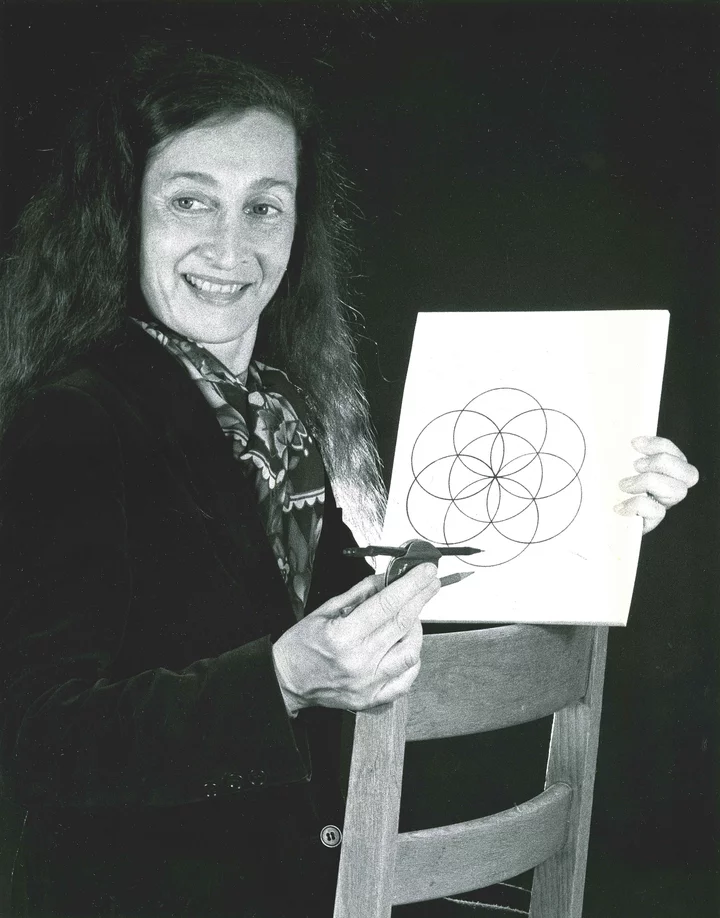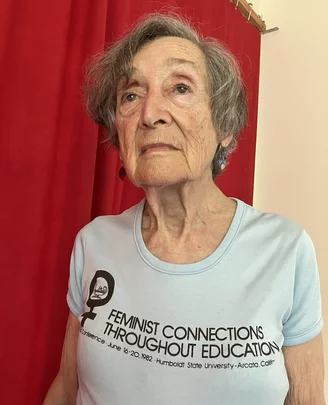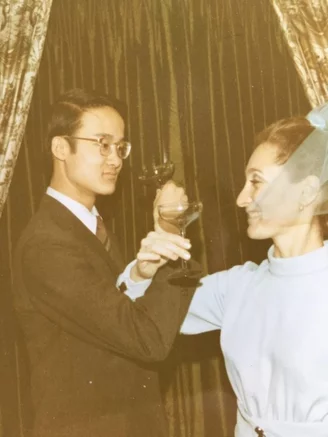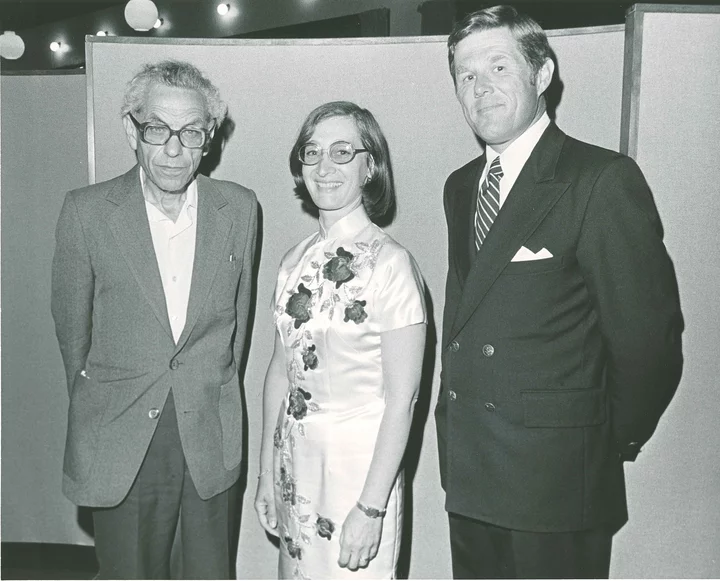Phyllis Zweig Chinn photographed as Outstanding Professor in the late 1980s. Photo: Cal Poly Humboldt Math Department.
“Are you prepared to be a role model?”
That was the question posed to Phyllis Zweig Chinn when she interviewed for a position at what was then Humboldt State University 50 years ago.
“I said, ‘Well, I am a female and, by virtue of that, I am certainly going to be a role model to women students, but I don’t have a chip on my shoulder about it,’” Chinn recalled in a sit-down with the Outpost at her Sunny Brae home last week.
“Which was kind of true until I got here,” she added, laughing.
Chinn became Humboldt’s first female math professor in fall 1975. When she started, women could be fired for getting pregnant. Workplace sexual harassment was years away from being a recognized concept. And the Equal Credit Opportunity Act, which allowed women to open bank accounts or lines of credit without a male co-signer, had passed just one year prior.
Yet over the next 35 years, from a home base in Arcata, Chinn would go on to publish over 60 “highly-cited” works and collaborate with some of the most renowned mathematicians of the time. She also served as Math Department chair and the founding faculty advisor of the university juggling club.
At 82, Chinn is small in stature and quick to smile. During our interview, she wore a T-shirt for a “Feminist Connections Throughout Education” conference she helped to organize in 1982 that brought women in academia from across the country – including feminist activist Angela Davis – to HSU.
Chinn’s affinity for the sciences began with her father, a pharmacist, who she said passed his love of the discipline on to her when he didn’t have a son.
As an undergrad at Brandeis University, Chinn thought she’d major in chemistry.
“The first day of class, the professor said, ‘You girls better forget about getting good grades, the guys need them to avoid the draft,’” she remembered. “By the end of the semester, I was no longer chemistry.”
After making the switch to mathematics – which she said she liked in part because she was good at it – Chinn graduated as the only female math major (out of four overall) in the class of 1962.
A year later, armed with a master’s in teaching from Harvard, she took the clearest path available to women in mathematics at the time: educating children. Swiftly realizing the junior high classroom was not suited to her goals, Chinn jumped on an opportunity to teach at the university level the following year.
“I decided I wanted to teach mathematics, not children,” she recalled. “For middle school kids, those two seemed pretty incompatible.”
Over her ensuing climb in academia, through years of teaching at teachers’ colleges and working to achieve her Ph.D, she lived moments that may have turned other women away from mathematics.
In Chinn’s case, underestimation seemed to egg her on.
When a male roommate at the University of California, San Diego told her she’d never succeed, she decided “if he could get a degree, so could I.”
When her thesis advisor told her that if she studied under him for three years, she’d understand enough that he could pick her thesis topic for her, she switched schools.
“‘Stick with me for three years and I’ll tell you,’” Chinn remembered, adding: “That was not appealing to my worldview.”
Moving from San Diego to Santa Barbara to complete her dissertation not only brought her to the field of math she’d go on to spend the majority of her career in – graph theory, which Chinn described as the study of relationships – but also to her husband Daryl, who chaired a human relations committee at the University of California, Santa Barbara.
“I saw his name in the campus newspaper and called him up and asked, ‘Are you going to be doing sensitivity group training?’,” Chinn remembered. Daryl answered “yes,” they were focusing on interracial relationship building on campus. The year was 1967, and UCSB was still “an almost wholly white enclave” (as historian Robert Lloyd Kelley wrote).
After they married, Chinn recalled attempting to renew a credit card with her new last name and being told, “‘We don’t give credit cards to women of productive age.’”
“They meant ‘reproductive’ age,” Chinn clarified.
As she remembers, she asked for a supervisor, threatened a lawsuit and received the card
“She’s not a radical,” Daryl chimed in, noting that Chinn didn’t burn her bra or frequent feminist demonstrations. But, he added, she would have been serious about the lawsuit if she hadn’t gotten the card.
When Chinn arrived at Humboldt, there was only one other tenure-track female professor in the College of Sciences outside of the nursing program: biology professor Sue Lee, who’d started at what was then Humboldt State College in 1969.
In an email to the Outpost, Lee said that while she felt generally supported and valued by colleagues in the male-dominated sciences departments, her fellow professors were “a product of their times” and she did experience instances of workplace sexual harassment.
“But being a product of my times too, I just did the best I could to avoid circumstances where that could happen,” Lee wrote.
In the Math Department, Chinn said she felt an unspoken sentiment among male colleagues that women were unsuited for the field. Nonetheless, when a tenure-track position opened at the end of her first year – she went for it.
“When I got it, there were certainly some people who said quietly that they thought it was because I was a woman,” she said.
Women students at the time also endured sexism in the College of Sciences, according to Lee, and “many” came to the women staff and faculty with frustrations about “inappropriate attitudes and behavior displayed by their male professors.”
“I was dismayed to say the least,” she wrote, adding that female staff in the College of Sciences shared her concerns. In response, Lee co-founded a student group called WINS (Women in Natural Resources and Sciences) alongside Jan Turner and Melanie Johnson, both of whom were administrative assistants in the sciences, which provided opportunities for women studying math, engineering, nursing and science to learn from women working in the field.
In a similar effort to smooth the path toward math and science for women, Chinn worked with Lori Dengler, professor of geology and resident North Coast earthquake/tsunami expert, to coordinate Expanding Your Horizons in Science and Math, which hosted annual conferences for girls grades 7-12.
During Chinn’s first semester at Humboldt, she became pregnant with her second child. Through a combination of luck and planning, both of her children were born in June – providing maternity leave in the form of summer breaks roughly 20 years before maternity leave was introduced. The next year, she said she surprised colleagues by nursing her son Wesley during meetings.
“Some of the male professors were kind of like, ‘Whoa, that’s pretty radical,’” she remembered with a smile.
By her recollection, Chinn remained the only tenure-track woman in the Math Department for more than a decade. And over the next three, she published on graph theory and combinatorics – a subfield of math concerned with counting and arranging – with preeminent mathematicians worldwide.
On the scale Erdős numbers, which denote the distance between mathematician Paul Erdős and another individual, as measured by academic papers, Chinn scores a one – meaning she published a paper with the distinguished Hungarian.
Chinn with mathematician Paul Erdős (left) and HSU President Alistair McCrone. Photo: Cal Poly Humboldt Math Department.
And Ronald L. Graham, renowned in the field of discrete mathematics, was instrumental in teaching Chinn to juggle, a hobby she said she was drawn to specifically because it was something for which she had “no natural aptitude” and wanted to see what it would take to overcome her lack of knack.
When she organized a graph theory/combinatorics conference with Joe Buhler, another juggling mathematician, she said they invited all the other mathematical jugglers they knew.
“This was an NSF [National Science Foundation]-paid juggling conference,” she laughed.
In the 1980s, she became the first faculty sponsor for a group of student jugglers who wanted to form a campus club. The organization lives on as the Humboldt Juggling Society today, and Chinn remained an avid juggler until she was diagnosed with Parkinson’s Disease in 2015.
Outside of math, Chinn taught classes in women’s studies, education and teacher preparation, science, interdisciplinary studies and religious studies.
“I probably taught a class in more different departments on campus than anybody before or after me,” she said, adding that her son learned to crawl in a women’s studies course she taught. He went on to become the “token male” women’s studies major in his class at Harvard.
But teaching prospective teachers was Chinn’s passion. As a proponent of “discovery method” learning, Chinn’s style focused on having students explain their reasoning and collaboratively think through alternative ways of doing things. She shared her philosophy with the teachers she taught, many of whom went on to become educators locally.
“Phyllis showed me not to be afraid of math,” said Loretta Eckenrode, a former student of Chinn’s who taught at Garfield Elementary and now serves as chair of the Humboldt County Office of Education Board of Trustees. “There’s a lot of kids and adults who say, ‘I’m not good at math, I can’t do that,’ and that wasn’t an option with Phyllis.”
Between 1992 and 1996, Chinn co-directed Project PROMPT (Professors Rethinking Options in Mathematics for Prospective Teachers) with Cal Poly’s Dale Oliver to increase interest and skills in mathematics teaching. Chinn was also a director of the Redwood Area Math Project (an outpost of the California Math Project) which ran summer camp-style sessions for teachers already in service.
“We went to camp and had a really good time – we spent 10 days just doing math,” said Eckenrode, who participated in RAMP. By expanding the number of ways she could understand and teach a concept, Eckenrode said she gained tools to help students for whom things weren’t clicking.
“I still see teachers who will tell me how much of a difference it [RAMP] made in the way they taught,” said Chinn, who considers herself a teacher of teachers (and mathematician) before trailblazer or glass ceiling-breaker.
As women’s representation at universities and in the workforce has grown – female students made up 58 percent of total undergraduate enrollment and male students made up 42 percent in 2021, according to the National Center for Education Statistics – their representation in lucrative and growing science, technology, engineering and mathematics (STEM) fields has continued to lag behind.
In fall 2023, women students made up 55 percent of Cal Poly Humboldt undergraduates. Comparatively, women will make up 34 percent of math major students (and 24 percent of overall Math Department faculty) this fall, according to Administrative Assistant Victoria Petrillo.
Chinn’s story reflects many of the factors studies find explain the gender gap in STEM, from stereotypes to “math anxiety” among teachers (the majority of whom are women).
After 35 years of teaching, Chinn retired from the university in 2010.
Today, she volunteers with the international peace organization Servas United States and the Red Cross. She also participates in a local support group for Parkinson’s and national studies of the disease.
“I felt that if I am going to have Parkinson’s, at least I can do everything I am able to contribute to the science of understanding and treating it,” she said.
Chinn said she’s grateful for changes she’s seen over the last 50 years as the university has become – in her eyes – a place more aware of the value of diversity. To this day, describing actions taken by Cal Poly Humboldt, Chinn still uses the term “we.”
To learn more about Chinn’s life, listen to an interview with her daughter, opera singer Hai-Ting Allison Chinn, for the StoryCorps Archive here.





CLICK TO MANAGE